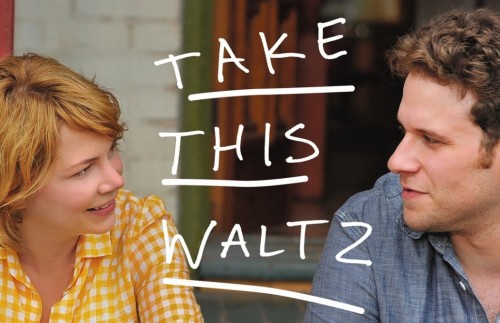On the heels of Lynn Shelton’s Your Sister’s Sister comes another indie dramedy about a love triangle, writer-director Sarah Polley’s Take This Waltz. Waltz is Polley’s follow-up to her universally acclaimed debut, Away With Her, and stars Michelle Williams as Margot, a married twentysomething copywriter who meets and falls for a man (Luke Kirby) while on vacation… who turns out to be her neighbor. Comedic actors Seth Rogen and Sarah Silverman add familiar faces and levity to the cast by playing Margot’s cookbook-writing husband, Lou, and Geraldine, Margot’s sister-in-law.
Audiences familiar with Away With Her will recognize the love triangle at the heart of Take This Waltz (a woman choosing between two men), but so will viewers of female-centered films as disparate as Twilight, It’s Complicated, and This Means War. It certainly seems that love triangles are much more habitual in women-friendly films than male-oriented ones. Why does that imbalance exist, and does it matter?
In the movies (and probably in life too), love triangles are rarely about love. Instead, they’re about values and priorities: familiarity or change? Stability or adventure? Virtue or vice? Sure, a situation where Meryl Streep or Reese Witherspoon is forced to choose between two attractive men provide double the eye candy (if Alec Baldwin still passes for eye candy), and there’s something deliciously indulgent, even decadent, about two suitors fighting to prove who loves our female protagonist more, especially when the sassy best friend is all alone. But in the end, the men being chosen are symbols of what the protagonist wants from life, and her choice represents the conclusion of her emotional, moral, or physical journey. The point isn’t romance, but growth and self-discovery.
Still, there’s something dispiriting about the fact that life decisions are packaged as the choice between Guy A and Guy B — as if it were beyond imagination that a woman isn’t married, or at least committed, by the end of a movie. And it niggles, too, that many female-centric movies don’t have much more at stake than their good taste in boyfriends. Most movies directed primarily at male audiences — that is, most movies — can’t afford a convoluted love story, since their (male) protagonists usually have something much more important to do than wooing, like tracking down the killer, bonding with his new partner, or both. A film like The Hunger Games, in which the female protagonist has much bigger worries than choosing between her best friend or her PR boyfriend, feels rare — and a love triangle is foisted upon Katniss anyway (!), despite her utter lack of interest in either of them.
Even if Take This Waltz doesn’t perform well at the box office, it shouldn’t slow down at all the prevalence of love triangles in female-friendly movies. It’s clearly a formula that sells, especially in franchises like Twilight and The Hunger Games, where fan discussions about which guy the girl should’ve chosen can extend the afterlife of a film through word-of-mouth and merchandise sales. And no matter how emphatically the heroine chooses, any love-triangle script that has two compelling suitors can add a kind of pleasant uncertainty that more straightforward films usually don’t — nobody debates, after all, whether Will Smith should have saved Earth after all. Ultimately, it matters very little that female-centered films disproportionately feature love triangles — but one hopes that the choice between two men reflects a female character’s struggles, rather than merely shopping around for a man.
__________________________________________________
Inkoo Kang is a Boston-based writer and regular contributor to Boxoffice Magazine whose work has appeared in Movieline, Pop Matters and Screen Junkies. She reviews stuff she hates, likes, and hate-likes on her blog THINK-O-VISION.







